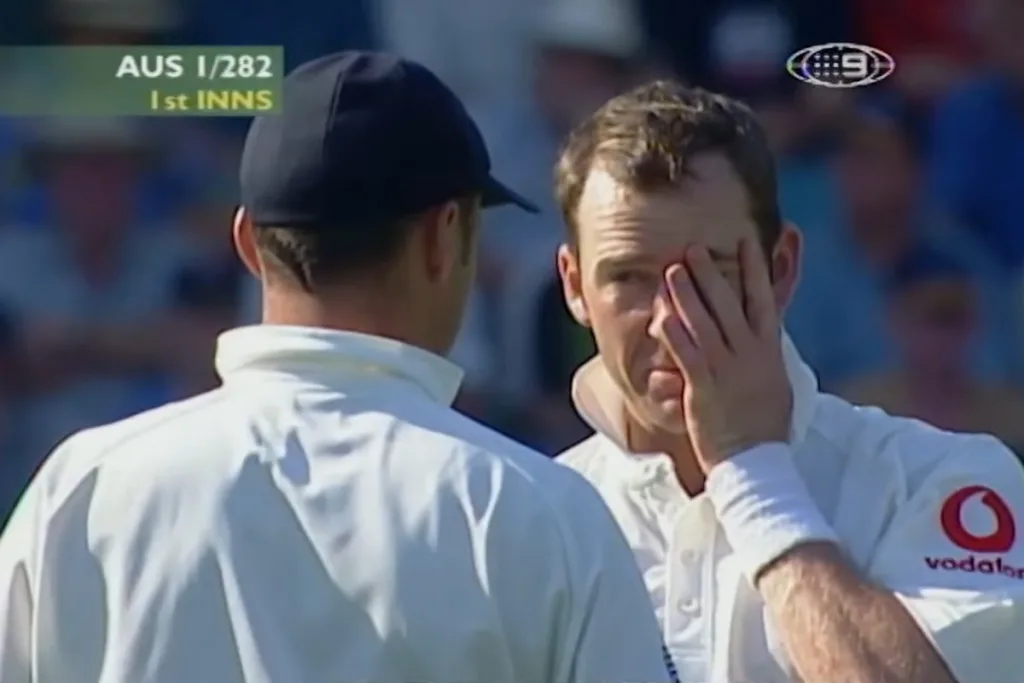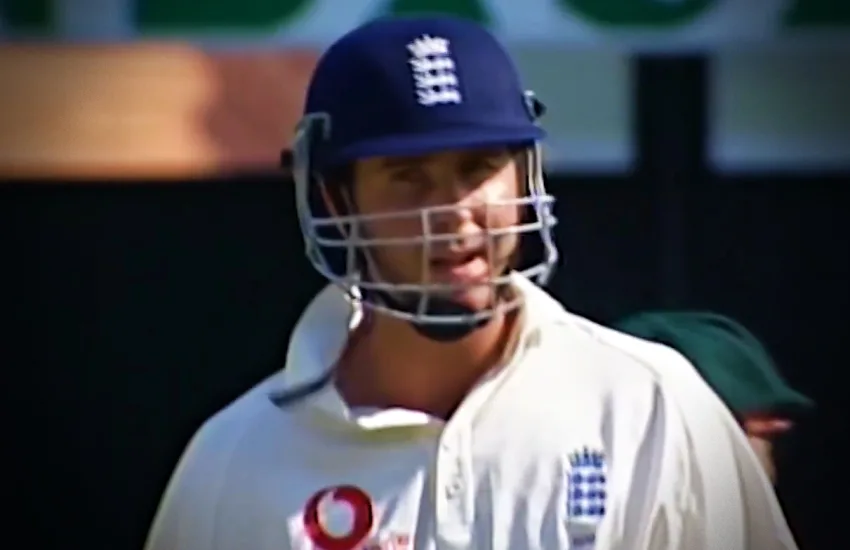aka The Vaughan Supremacy
As we’ve already told you (multiple times) we’ve got a book out, co-written with Dan Liebke: The 50 Most Ridiculous Ashes Moments. In it, we count down exactly what that title promises. But of course there have been far more than 50 ridiculous moments in the last five decades of Ashes cricket, so we’ve also published a bit of the overspill by way of promoting the thing. Dan previously ran the 52nd most ridiculous Ashes moment – Mark Waugh replacing Steve Waugh – over on his site and below we bring you the 51st most ridiculous moment: Michael Vaughan declining a crushing. These two chapters aren’t in the book, but they should give you a pretty good feel for its contents nonetheless. Please buy The 50 Most Ridiculous Ashes Moments! Stocks are (genuinely) limited, so no time like the present! Ideal Christmas present etc etc.
England were crushed in the 2002/03 Ashes. This wasn’t a colossal surprise for three key reasons.
- Crush-happy Steve Waugh was leading an Australia side that was near enough at its peak (and to be honest was still pretty handy even at its nadir)
- England were England
- England were England in Australia
The margins of victory across the first four Tests were 384 runs, an innings and 51 runs, an innings and 48 runs and five wickets. A Warne-and-McGrath-less XI then suffered an unlikely dead rubber defeat in the fifth Test.
Warne had dislocated his shoulder for that last match. Never one to offer the opposition much encouragement, Waugh said of his replacement, Stuart MacGill: “I have gone on record that he’s in the top couple of spinners in the world.”
McGrath, meanwhile, had, “suffered a left side strain to his ‘grunt’ muscle,” according to team physio Errol Alcott, who was clearly not averse to blinding his audience with science.
Notable absentees aside, that fifth Test victory was to a great extent down to the efforts of the one England player to emerge from the series uncrushed: a young, upright opener called Michael Vaughan, who had begun his year ranked 40th in the world behind Ridley Jacobs and Neil McKenzie, but who would subsequently rise to number one, ahead of Matthew Hayden and Sachin Tendulkar, a month or two after the series had finished.
None of England’s other batters fared well. And nor did their bowlers.

Over the course of the series, all of England’s other players combined managed just one hundred: Mark Butcher’s 124 in that fifth Test. Australia’s batters managed eight – despite getting two fewer innings.
Warne, McGrath and Jason Gillespie all averaged under 25 with the ball (as did Waugh and Damien Martyn1, if you include part-timers – which for the purposes of the point being made here, we may as well.) No England bowler averaged less than 30. The pick of them was Ashley Giles, who managed 31.83 after taking 6-191 in the only Test he played.
At the other end of the scale, Steve Harmison averaged 50, Matthew Hoggard 60, Alex Tudor 70 (from one Test) and Richard Dawson almost 80 (rather more damningly, from four Tests).
Say what you like about Gilo, but we all know that successful Ashes tours to Australia are not on The King of Spain’s bowling built.
Michael Vaughan, however, seemed blissfully unaware of all this. As his teammates were being compressed all around him, the oblivious Yorkshireman hit three hundreds and averaged 63.30.
Vaughan’s upturn in output that year was vertiginous, but his capacity to play like someone airlifted in from an entirely different cricket team had already been noted. That quality was, in fact, the chief reason he’d managed to retain his place in the side even without any properly big scores.
The first time he’d walked out to bat for England in a Test match, they’d been 2-2 against South Africa, and by the time he actually faced his first ball, they were 2-42. Batting initially with another debutant, Chris Adams, Vaughan saved his team from complete ignominy with one of the more sizeable 33s3, given the context.
Two and a half years and 16 Test matches later, however, his record was the definition of mediocrity: just one hundred and an average of 31.15. This wasn’t good enough, so in April 2002 he resolved to instantly and completely master Test match batting.
In his next Test, against Sri Lanka at Lord’s, he top-scored in both innings. His first innings 64 wasn’t enough to save the follow-on, so he made 115 in the second to secure the draw.
Against India, later in the summer, he hit three hundreds in four Tests – a second of the summer at Lord’s, 197 at Trent Bridge and 195 at the Oval. He scored 615 runs in the series – 300 more than England’s second highest scorer, Nasser Hussain – and averaged 102.50. To further contextualise those efforts, England could still only draw the series 1-1.
Then he had knee surgery.
Then it was time to go to Australia.
The first Test in Brisbane was famously no contest at all after Hussain won the toss and elected to bowl (see chapter [redacted]). Vaughan was twice dismissed by McGrath, including a first ball lbw in the second innings. Further burnishing his credentials as a textbook England Ashes tourist, he also dropped two catches.
Ahead of the second Test in Adelaide, Vaughan twisted his knee in the warm-up which meant that Hussain apparently walked out to the toss not knowing whether he would even be fit to play or not.
Hussain called correctly and – not entirely surprisingly – decided he’d have a bat this time. It turned out Vaughan was fit to play. And play he did. He was dismissed in the final over of the day for 177.
Vaughan’s first boundary in that innings was a pull shot off Andy Bichel that went for six. The delivery didn’t seem quite short enough to warrant the shot, but he got away with it. He then carried on getting away with similar shots for the whole of the rest of the series, narrowing the ‘good length’ band of pitch – within which balls are considered too short to drive but too full to pull – to barely a sliver.
No side had lost a Test at Adelaide batting first since 1966 – but this England side was made of different stuff. The other 10 batters combined couldn’t quite match Vaughan in the first innings and contributed just 150 runs between them. Australia countered with 552-9 and then bowled the tourists out for 159 (of which Vaughan made 41).
A week later, Australia retained the Ashes with another innings victory in Perth. Vaughan’s significant contributions included running out partner Mark Butcher in the first innings before falling victim to Butcher returning the favour in the second.
Shortly after, it was revealed that as well as his dodgy knee, Vaughan had been playing with a fractured shoulder sustained when he was hit by a Jason Gillespie delivery during his second Test hundred.
“It hasn’t stopped me playing and it hasn’t stopped me doing anything so I don’t perceive it to be any sort of problem,” he said.
It certainly didn’t stop him scoring massive hundreds. In Melbourne, he made 145 out of England’s second innings 387, as the tourists succumbed to a five-wicket defeat. If progress can be measured by the day on which a team loses, on this occasion the tourists could at least celebrate surviving to day five.
But then came the victory in Sydney. A duck in the fourth over of the match didn’t seem to foreshadow such a thing, but then lo! What was this? An England player who was not Michael Vaughan seeing fit to contribute?
Butcher’s 124 wasn’t quite enough to prevent Australia taking a colossal one-run first innings lead, thanks to Steve Waugh’s century off the final ball of day two (see chapter [redacted]). But Vaughan still had an innings to play. He used it to make 183, which meant that even though Hussain was the only other batter to pass 40, Australia now faced a towering fourth innings target of 452.
Despite a half-hearted, and swiftly aborted, reversal of the batting order that saw Bichel come in at three, they fell 225 runs short, with Andy Caddick taking 7-94. Could there be something in this ‘players who are not Michael Vaughan also contributing somehow’ strategy? Perhaps if England could really lean into this in 2005, their relentless Ashes compaction might finally come to an end.
- First innings top-scorer, Rob Key, clean bowled for 47 at the WACA in case you’re wondering – “a stout, mostly passive knock,” according to Wisden. ↩︎
- In the Australian version of this book, this will be switched to 4-2. The 2-2 above will similarly be switched to 2-2. ↩︎
- An LP of an innings, if you will. ↩︎
So, to reiterate, The 50 Most Ridiculous Ashes Moments is out in the UK next week, but you don’t have to wait. You can order it now to arrive ASAP – and we would greatly appreciate it if you did because this kind of thing really goes down well with publishers.
Our preferred outlet for both moral and commission-based reasons is bookshop.org but we’d ideally like to sell all the copies that have ended up elsewhere as well.

We’ve also seen it for sale at TGJones (WH Smith to you), Blackwell’s and Awesome Books.
If you make a strong and compelling case, we will also permit you to buy The 50 Most Ridiculous Ashes Moments from Amazon. This is our least favoured option, but we would rather you buy it from Amazon than not buy it at all.
Meanwhile, it came out yesterday in Australia and has already been sighted in a shop. If you’re Down Under, you’ll find a list of places where you can get it on this page.


